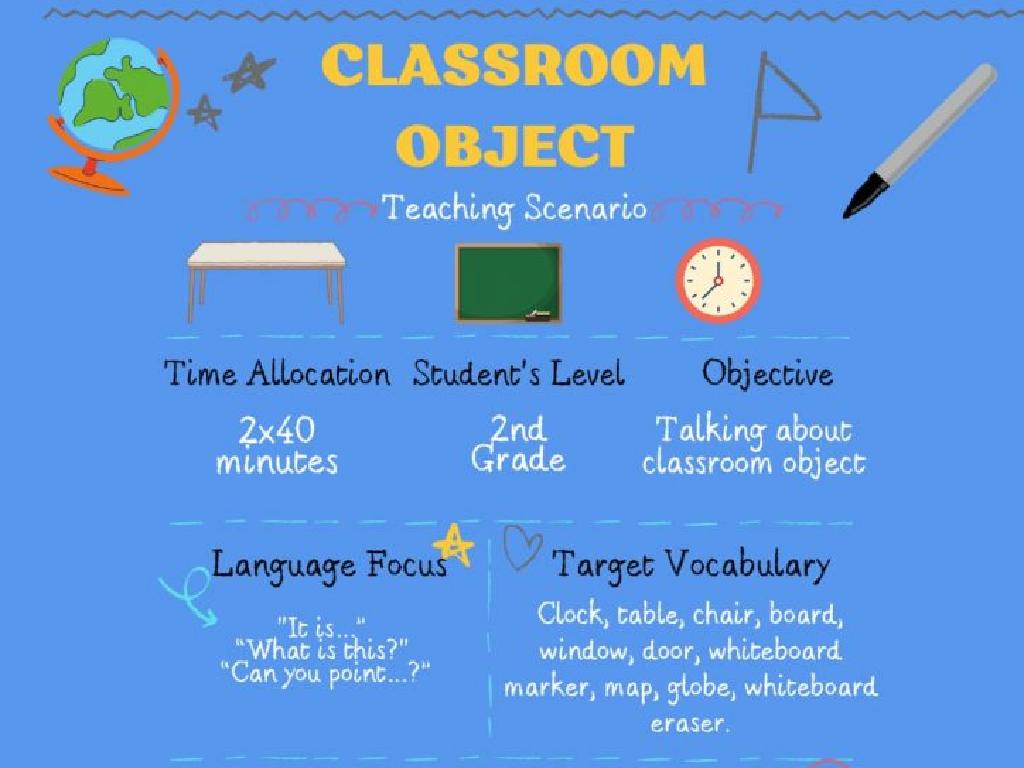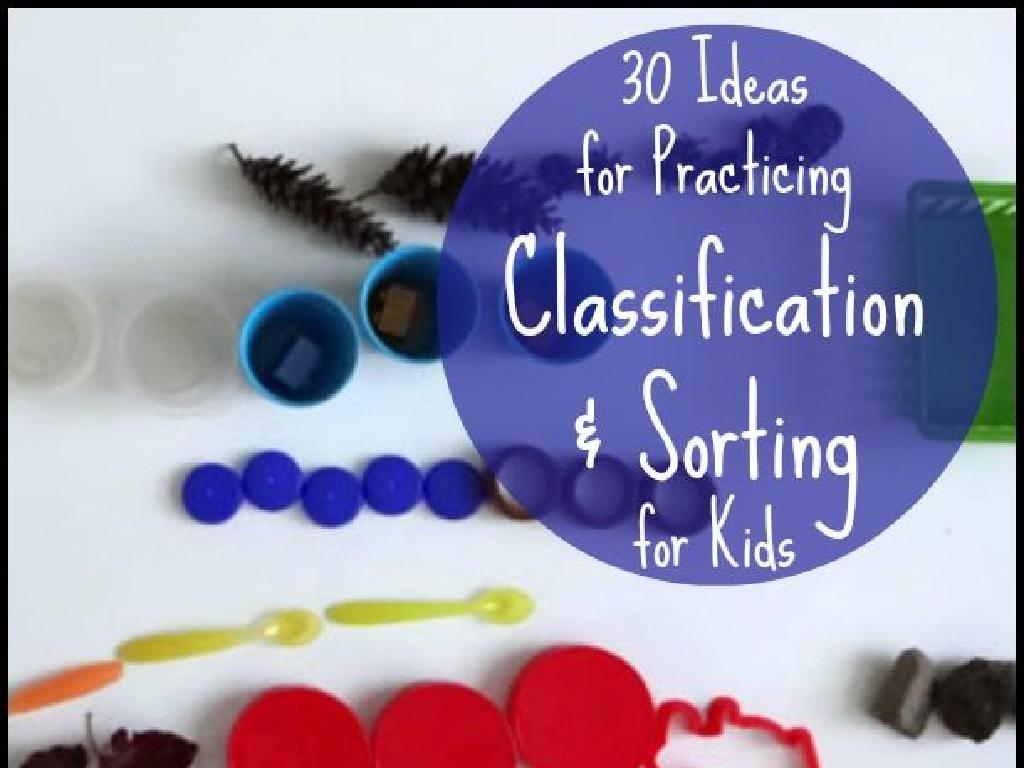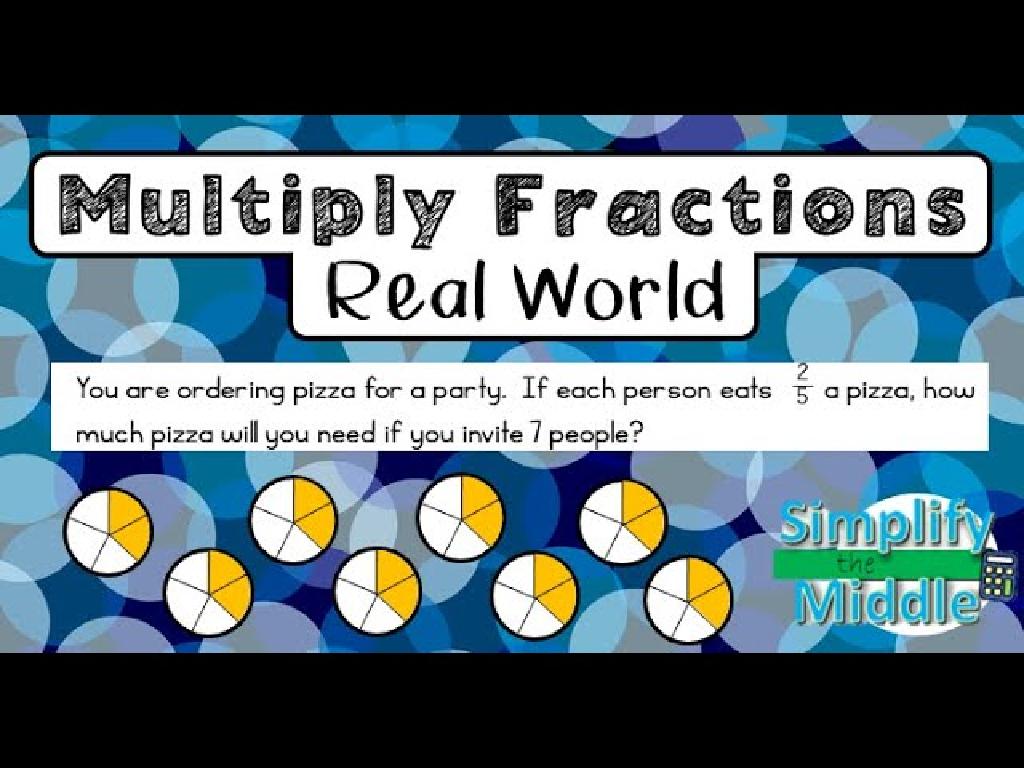Make Halves, Thirds, And Fourths
Subject: Math
Grade: Second grade
Topic: Fractions
Please LOG IN to download the presentation. Access is available to registered users only.
View More Content
Welcome to Fractions!
– Learning halves, thirds, fourths
– Splitting things into 2, 3, or 4 equal parts
– Parts of a whole explained
– Each piece of a cut-up apple represents a fraction
– Fractions in daily life
– Using fractions when sharing snacks or reading a clock
– Fun with fraction activities
|
Today’s lesson introduces the concept of fractions, specifically halves, thirds, and fourths, to second graders. Begin by explaining that a fraction represents a part of a whole, like a piece of a pie. Use tangible examples like cutting an apple into equal parts to illustrate halves, thirds, and fourths. Relate fractions to everyday scenarios, such as dividing a pizza among friends or determining the time by looking at a clock. Engage the class with activities where they can practice making fractions with objects like paper folding or drawing. This hands-on approach helps solidify their understanding of fractions as parts of a whole.
Understanding Fractions: Halves, Thirds, and Fourths
– Fractions show parts of a whole
– Like a pizza cut into equal slices
– Numerator: The top number
– Tells us how many parts we have
– Denominator: The bottom number
– Tells us into how many total parts
– Examples: 1/2, 1/3, 1/4
– Halves (2 pieces), thirds (3 pieces), fourths (4 pieces)
|
Begin by explaining that fractions are a way to represent parts of a whole, similar to cutting a pizza into equal slices. The numerator, or top number, indicates how many slices we’re focusing on, while the denominator, the bottom number, shows the total number of equal parts the whole is divided into. Use visual aids like pie charts or pizza drawings to illustrate halves (1/2), thirds (1/3), and fourths (1/4). Encourage students to think of other examples of fractions they encounter in daily life, such as sharing snacks or dividing toys among friends.
Understanding Halves
– What is a half?
– A half means dividing something into 2 equal parts.
– Each part is one of two
– When you split something into 2 equal parts, each part is 1 out of the 2.
– Writing halves: 1/2
– The fraction 1/2 represents one half.
– Examples of halves
– Like cutting a sandwich into 2 equal pieces, or 30 minutes being half an hour.
|
This slide introduces the concept of halves to second-grade students. Begin by explaining that a half is created when something is divided into two equal parts. Emphasize that each part is equal and represents one out of the two total parts. Show how this is written as the fraction 1/2. Use tangible examples such as dividing a sandwich or an apple into two equal pieces to illustrate the concept. Explain that 1/2 an hour is the same as 30 minutes to help them relate to time. Encourage students to think of other examples of halves in their daily lives and discuss why understanding halves is important.
Understanding Thirds in Fractions
– Divide into 3 equal parts
– Each part is one third
– Imagine cutting a pizza so everyone gets an equal slice.
– Represented as 1/3
– See thirds in everyday things
– Like 1/3 of a pie or $0.33 of a dollar
|
This slide introduces the concept of thirds to second-grade students. Begin by explaining that a third means something is divided into three equal sections. Each section is called one third and is written as 1/3. Use tangible examples like slicing a pie or dividing a dollar into three equal parts to illustrate the concept. Encourage students to visualize dividing objects they are familiar with into thirds to better understand the fraction 1/3. Ask students to draw examples of items divided into thirds to reinforce the concept.
Making Fourths in Fractions
– What is a fourth? Divide into 4 equal parts
– Each part is one fourth: written as 1/4
– Example: 1/4 of a pizza shows a fourth
– If you cut a pizza into 4 equal slices, each slice is 1/4
– Example: 15 minutes is 1/4 of an hour
– There are 60 minutes in an hour, so 15 minutes is 1/4 of it
|
This slide introduces the concept of fourths, which is a fundamental part of understanding fractions. Explain that when something is divided into 4 equal parts, each part is called a fourth, and it is represented as 1/4. Use tangible examples like a pizza cut into 4 slices or the 15-minute intervals of an hour to illustrate the concept. Make sure to clarify that all parts must be equal for it to be a fourth. You can bring a play pizza for a class activity or use a clock to visually demonstrate how 15 minutes is a quarter of an hour. Encourage the students to think of other examples of fourths and share them with the class.
Let’s Practice Fractions Together!
– Cut out shapes and divide
– Divide shapes into 2, 3, or 4 equal parts
– Label each part with fractions
– Write 1/2, 1/3, 1/4 on each part
– Share your shapes with classmates
– Show and tell how you divided your shape
– Understand halves, thirds, fourths
– Grasping equal parts concept
|
This slide is for a class activity where students will engage in a hands-on task to understand fractions by cutting out shapes and dividing them into equal parts. Provide students with safety scissors, paper, and guidance to ensure they can cut shapes safely and accurately. Encourage them to think about what it means for parts to be ‘equal’. After they label each part with the correct fraction, have a sharing session where each student explains their process and reasoning. This will reinforce their understanding of fractions and provide an opportunity for peer learning. Prepare additional shapes in case some students need more practice, and consider pairing students to foster collaboration.
Class Activity: Fraction Fun!
– Create a fraction pizza
– Use paper plates & colored paper
– Cut & divide pizza into fractions
– Halves, thirds, or fourths – choose one
– Decorate slices to show fractions
– Each slice can have different toppings to represent different fractions
|
This hands-on activity is designed to help second graders understand the concept of fractions in a fun and creative way. Provide each student with a paper plate and colored paper for toppings. Guide them to cut the paper into shapes that represent toppings like pepperoni, mushrooms, or peppers. Students will then divide their ‘pizza’ into equal parts – halves, thirds, or fourths, depending on what you’re focusing on. They will glue the toppings onto each ‘slice’ to visually represent fractions. For example, if a pizza is divided into thirds, one slice could have three toppings, another two, and another one, to show 1/3, 2/3, and 3/3. Encourage creativity and ensure they understand that each slice represents a fraction of the whole pizza. This activity can be adapted for different levels by changing the number of fractions or by introducing mixed fractions.
Fun with Fractions: Halves, Thirds, and Fourths
– Understanding fractions
– A fraction represents a part of a whole
– Visualizing halves, thirds, fourths
– Use objects like pizza or apples to show parts
– Fractions in daily life
– Slicing a cake, sharing toys, or measuring ingredients
– Questions and review
|
This slide aims to consolidate the students’ understanding of fractions by reviewing what they are and visualizing them with relatable examples. Begin by explaining that a fraction represents a part of a whole, such as a piece of fruit or a slice of pizza. Encourage students to think of examples of halves, thirds, and fourths using objects they are familiar with. Discuss how fractions are used in everyday life, like dividing a cake into equal parts at a birthday party or sharing toys with friends. Conclude with a Q&A session to address any uncertainties and to reinforce their knowledge. The goal is to ensure that students can recognize and apply the concept of fractions in various contexts.
Homework Challenge: Fraction Pizza Fun!
– Take your fraction pizza home
– Explain pizza parts to your family
– Each slice represents a fraction of the whole pizza
– Practice fractions with home objects
– Use toys or snacks to make halves, thirds, and fourths
– Show and tell in the next class
|
This homework activity is designed to reinforce the concept of fractions by using a relatable and tangible example: pizza. Students will take home a paper pizza divided into fractions and explain to their family what each part represents, thereby teaching the concept to someone else to solidify their own understanding. Encourage them to practice making halves, thirds, and fourths with everyday objects, such as splitting an apple into equal parts or dividing a pack of crayons. This hands-on experience will help them grasp the idea of fractions in a fun and interactive way. In the next class, have a show and tell for students to share their experiences and learnings.






